As with anything, stretching should be introduced progressively. "Intensity" and "volume" are difficult to gauge so it's best to be conservative until your body has had time to acclimate to increased range of motion. Although the following stretches can be done at varying speeds and amplitudes, I would suggest starting slow and static, gradually increasing frequency and duration before experimenting with ballistic and dynamic variations.
Pavel says that, stretching, you are trying to "find space" and it's a great way to phrase it. As you stretch, you are finding space within a, heretofore, restricted range of motion.
The following stretches are my "go to" stretches - they have been my "go to" stretches for years. Although I don't do all of them every day, I find time to do most whenever I am in front of a television, or waiting for my wife to finish shopping, or have a spare moment. Stretching does not have to be a full-blown 30 minute yoga session - it can be as short as an elevator ride or a longer than expected phone call.
Dislocates, or partial dislocates, can be done with a broomstick, dowel, rope, or towel. Taking too narrow a grip too quickly is asking for elbow strain.
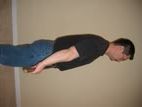
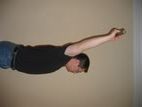
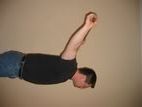
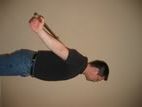
Two-armed and one-armed variations stress different angles and ranges of motion. Changing the hand position will shift stress of the shoulder girdle to target the scapulae and anterior shoulder girdle.







This stretch doesn't have to be done in a doorway - it can be done against a wall, in a power rack, or a goal post. The whole forearm should be solidly braced and the body turned to lightly stretch the shoulder and pectoral region.


Elevating the scapula while performing the stretch will shift stress from the tricep to the lat, infraspinatus, and teres minor.
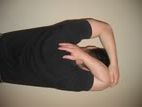
Avoid excessive lower back flexion. Slightly bending the knees (as in a good morning or romanian deadlift) will shift stress from the hamstring insertion at the knee to the hamstring muscle bellies and origins at the hip.

As with the good morning stretch, care should be taken not to excessively flex the lumbar.


I see people struggle with this one all the time - most of the time it becomes just another hamstring stretch rather than hitting the IT band as intended. The key with this stretch is to kick the hip out slightly in the direction of the rear positioned leg. Notice in the pics below my hips move to the left as the upper body moves to the right.



Gently leaning side to side while on all fours will hit the glutes. I don't remember how I "discovered" this one, but it is one of the simplest, yet most effective stretches I have found for the area.



This is another stretch I see performed incorrectly all the time. Done incorrectly, it places stress squarely on the knee joint. Initiated from the hip, it will stretch the hip flexor and quad muscles.






2 comments:
So much easy accessible info out there, so I do appreciate your comment. Thanks.
There are a lot of great poses that stretch the shoulders. It’s one of the best benefits I get from yoga. I found Leeann Carey has an awesome free yoga video on shoulder stretches that I thought your readers might like: http://www.planetyoga.com/yoga-blogs/free-yoga-video-shoulder-stretches-for-improved-mobility/
Post a Comment